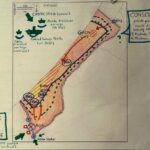2 texts, questions and a timechart on India before 1857
A Timechart on India
Vous souhaitez lire la suite ?
Actifs dans le débat public sur l'enseignement de nos disciplines et de nos pratiques pédagogiques, nous cherchons à proposer des services multiples, à commencer par une maintenance professionnelle de nos sites. Votre cotisation est là pour nous permettre de fonctionner et nous vous en remercions.
|
|
|
Source A – In the 1830s, the policy of leaving India after carrying out a series of reforms that would enable it to look after itself still had some supporters; by 1870 very few Englishmen thought the idea of leaving India was worth any consideration. The self-governing colonies were in a quite different position; they were welcome to look after themselves […] While the colonies of white settlement were moving to a new and more detached relationship with Britain, under responsible government, India at the end of the 1840s was entering a new and dramatic cycle of modernization and reaction. After the Sikh Wars, the pendulum swung back to peace and westernization: the Punjab had to be pacified and put under British administration […] and the new Governor-General, Lord Dalhousie, threw himself into the work of developing India with fewer doubts and afterthoughts than any of his predecessors or successors […] and Dalhousie thought it his duty to bring the advantage of this new way of life to India […] Large sections of Indian society responded as Dalhousie wished, by accepting his innovations and believing that the path of the new rulers was one they should tread without too many questions.
T. O. Lloyd, The British Empire, 1558-1995, Oxford University Press, 1995, p. 172 sq. |
|
|
Source B – The most visible effect of Dalhousie’sBritish Governor appointed by the British East India Company (BEIC). activity was the creation of a system of communication that united all India. Previously it had been very hard for anyone except the few men at the top who ruled the whole country to see India – whatever its political boundaries – as a unity. The building of the great road from Calcutta to Peshawar, with a branch to Bombay forking off just south of Delhi; opened up a route that united northern India in a way quite unlike anything before it […] and […] there is no need to doubt that it seemed like a river of life when it was being built in the 1840s […] Electric telegraph […] (were) put up in the 1850s […] In the eighteenth century several countries had postal services but all of them, including those in Britain and in the Moghul Empire, were expensive and were designed more for the convenience of the government users than of private citizens. In 1840 the system in Britain was transformed to allow a letter to be delivered anywhere in the country for a uniform rate of a penny, a step that could be justified only if there turned out to be an immense load of correspondence that would be sent if the rates were low enough. Dalhousie had seen the change and had seen that it had been completely successful, and he set up a universal system for India. As wages in India were lower than in -Britain he decided -that delivery anywhere from Ceylon to the Himalayas could be provided for a halfpenny, which reduced the cost of writing from Bombay to Calcutta to about 3 per cent of what it was before. The reduction attracted a vast increase in postal activity, and covered its costs. Probably not many people in Srinagar wrote to Trincomalee but it did mean that ordinary Indians (including the illiterate, who hired letter-writers) could write to their families when away from home and that politically-minded lndians could keep in touch with their colleagues in other parts of the country; and there were collections of mail for Britain once a fortnight […] There had -been fears that the cost and the problems of caste difference and timidity about novelty would keep Indians from the trains. None of these factors had any visible effect; Indian trains were at once overcrowded and remained overcrowded as the track spread across India in the next generation. As Marx might have said, all the boundaries of family and tradition are swept away by cheap tickets […]
T. O. Lloyd, The British Empire 1558-1995, op. cit., p. 172 sq. |












